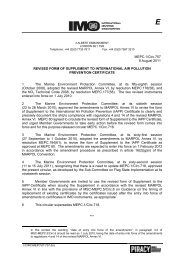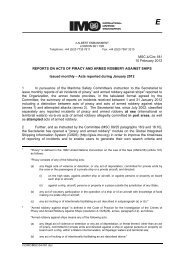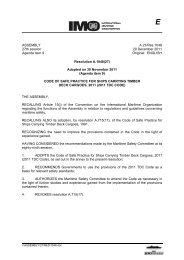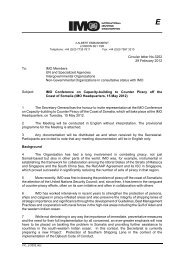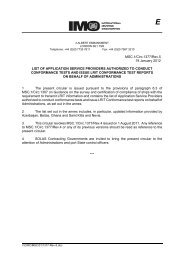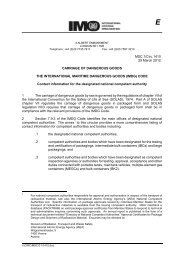Resolution A.1045(27) - 749626 www.mardep.gov.hk
Resolution A.1045(27) - 749626 www.mardep.gov.hk
Resolution A.1045(27) - 749626 www.mardep.gov.hk
- No tags were found...
You also want an ePaper? Increase the reach of your titles
YUMPU automatically turns print PDFs into web optimized ePapers that Google loves.
EASSEMBLY<strong>27</strong>th sessionAgenda item 9A <strong>27</strong>/Res.104520 December 2011Original: ENGLISH<strong>Resolution</strong> <strong>A.1045</strong>(<strong>27</strong>)Adopted on 30 November 2011(Agenda item 9)PILOT TRANSFER ARRANGEMENTSTHE ASSEMBLY,RECALLING Article 15(j) of the Convention on the International Maritime Organizationregarding the functions of the Assembly in relation to regulations and guidelines concerningmaritime safety,NOTING the provisions of regulation V/23 of the International Convention for the Safety ofLife at Sea (SOLAS), 1974, as amended,HAVING CONSIDERED the recommendation made by the Maritime Safety Committee at itseighty-seventh session,1. ADOPTS the "Recommendation on Pilot Transfer Arrangements", as set out in theAnnex to the present resolution;2. INVITES Governments to draw the attention of all concerned to thisrecommendation;3. FURTHER INVITES Governments to ensure that mechanical pilot hoists arenot used;4. REQUESTS Governments to ensure that pilot ladders and their arrangements, useand maintenance conform to standards not inferior to those set out in the annex to thepresent resolution;5. REVOKES resolution A.889(21).I:\ASSEMBLY\<strong>27</strong>\RES\1045.doc
A <strong>27</strong>/Res.1045Page 2AnnexRECOMMENDATION ON PILOT TRANSFER ARRANGEMENTS1 GENERALShip designers are encouraged to consider all aspects of pilot transfer arrangements at anearly stage in design. Equipment designers and manufacturers are similarly encouraged,particularly with respect to the provisions of paragraphs 2.1.2, 3.1 and 3.3.2 PILOT LADDERSA pilot ladder should be certified by the manufacturer as complying with this section or withthe requirements of an international standard acceptable to the Organization. 12.1 Position and construction2.1.1 The securing strong points, shackles and securing ropes should be at least asstrong as the side ropes specified in section 2.2 below.2.1.2 The steps of the pilot ladders should comply with the following requirements:.1 if made of hardwood, they should be made in one piece, free of knots;.2 if made of material other than hardwood, they should be of equivalentstrength, stiffness and durability to the satisfaction of the Administration;.3 the four lowest steps may be of rubber of sufficient strength and stiffness orother material to the satisfaction of the Administration;.4 they should have an efficient non-slip surface;.5 they should be not less than 400 mm between the side ropes, 115 mm wideand 25 mm in depth, excluding any non-slip device or grooving;.6 they should be equally spaced not less than 310 mm or more than 350 mmapart; and.7 they should be secured in such a manner that each will remain horizontal.2.1.3 No pilot ladder should have more than two replacement steps which are secured inposition by a method different from that used in the original construction of the ladder, andany steps so secured should be replaced as soon as reasonably practicable by stepssecured in position by the method used in the original construction of the pilot ladder.When any replacement step is secured to the side ropes of the pilot ladder by means ofgrooves in the sides of the step, such grooves should be in the longer sides of the step.1Refer to the recommendations by the International Organization for Standardization, in particularpublication ISO 799:2004, Ships and marine technology – Pilot ladders.I:\ASSEMBLY\<strong>27</strong>\RES\1045.doc
A <strong>27</strong>/Res.1045Page 32.1.4 Pilot ladders with more than five steps should have spreader steps not lessthan 1.8 m long provided at such intervals as will prevent the pilot ladder from twisting.The lowest spreader step should be the fifth step from the bottom of the ladder and theinterval between any spreader step and the next should not exceed nine steps.2.1.5 When a retrieval line is considered necessary to ensure the safe rigging of a pilotladder, the line should be fastened at or above the last spreader step and should leadforward. The retrieval line should not hinder the pilot nor obstruct the safe approach of thepilot boat.2.1.6 A permanent marking should be provided at regular intervals (e.g. 1 m) throughoutthe length of the ladder consistent with ladder design, use and maintenance in order tofacilitate the rigging of the ladder to the required height.2.2 Ropes2.2.1 The side ropes of the pilot ladder should consist of two uncovered ropes not lessthan 18 mm in diameter on each side and should be continuous, with no joints and havea breaking strength of at least 24 Kilo Newtons per side rope. The two side ropes shouldeach consist of one continuous length of rope, the midpoint half-length being located on athimble large enough to accommodate at least two passes of side rope. 2.2.2 Side ropes should be made of manila or other material of equivalent strength,durability, elongation characteristics and grip which has been protected against actinicdegradation and is satisfactory to the Administration.2.2.3 Each pair of side ropes should be secured together both above and below each stepwith a mechanical clamping device properly designed for this purpose, or seizing methodwith step fixtures (chocks or widgets), which holds each step level when the ladder ishanging freely. The preferred method is seizing. 23 ACCOMMODATION LADDERS USED IN CONJUNCTION WITH PILOT LADDERS3.1 Arrangements which may be more suitable for special types of ships may beaccepted, provided that they are equally safe.3.2 The length of the accommodation ladder should be sufficient to ensure that its angleof slope does not exceed 45°. In ships with large draft ranges, several pilot ladder hangingpositions may be provided, resulting in lesser angles of slope. The accommodation laddershould be at least 600 mm in width.3.3 The lower platform of the accommodation ladder should be in a horizontal positionand secured to the ship's side when in use. The lower platform should be a minimum of 5 mabove sea level.3.4 Intermediate platforms, if fitted, should be self-levelling. Treads and steps of theaccommodation ladder should be so designed that an adequate and safe foothold is given atthe operative angles.Refer to the recommendations by the International Organization for Standardization, in particularpublication ISO 799:2004, Ships and marine technology — Pilot ladders, part 4.3a and part 3,paragraph 3.2.1.I:\ASSEMBLY\<strong>27</strong>\RES\1045.doc
A <strong>27</strong>/Res.1045Page 56 SAFE APPROACH OF THE PILOT BOATWhere rubbing bands or other constructional features might prevent the safe approach of apilot boat, these should be cut back to provide at least 6 metres of unobstructed ship's side.Specialized offshore ships less than 90 m or other similar ships less than 90 m for whicha 6 m gap in the rubbing bands would not be practicable, as determined by theAdministration, do not have to comply with this requirement. In this case, other appropriatemeasures should be taken to ensure that persons are able to embark and disembark safely.7 INSTALLATION OF PILOT LADDER WINCH REELS7.1 Point of access7.1.1 When a pilot ladder winch reel is provided it should be situated at a position whichwill ensure persons embarking on, or disembarking from, the ship between the pilot ladderand the point of access to the ship, have safe, convenient and unobstructed access to oregress from the ship.7.1.2 The point of access to or egress from the ship may be by a ship's side opening, anaccommodation ladder when a combination arrangement is provided, or a single section ofpilot ladder.7.1.3 The access position and adjacent area should be clear of obstructions, including thepilot ladder winch reel, for distances as follows:.1 a distance of 915 mm in width measured longitudinally;.2 a distance of 915 mm in depth, measured from the ship's side platinginwards; and.3 a distance of 2,200 mm in height, measured vertically from the accessdeck.7.2 Physical positioning of pilot ladder winch reels7.2.1 Pilot ladder winch reels are generally fitted on the ship's upper (main) deck or at aship's side opening which may include side doors, gangway locations or bunkering points.Winch reels fitted on the upper deck may result in very long pilot ladders.7.2.2 Pilot ladder winch reels which are fitted on a ship's upper deck for the purpose ofproviding a pilot ladder which services a ship side opening below the upper deck or,alternatively, an accommodation ladder when a combination arrangement is provided should:.1 be situated at a location on the upper deck from which the pilot ladder isable to be suspended vertically, in a straight line, to a point adjacent to theship side opening access point or the lower platform of the accommodationladder;.2 be situated at a location which provides a safe, convenient and unobstructedpassage for any person embarking on, or disembarking from, the shipbetween the pilot ladder and the place of access on the ship;I:\ASSEMBLY\<strong>27</strong>\RES\1045.doc
A <strong>27</strong>/Res.1045Page 6.3 be situated so that safe and convenient access is provided between thepilot ladder and the ship's side opening by means of a platform whichshould extend outboard from the ship's side for a minimum distanceof 750 mm, with a longitudinal length of a minimum of 750 mm.The platform should be securely guarded by handrails;.4 safely secure the pilot ladder and manropes to the ship's side at a point onthe ships side at a distance of 1,500 mm above the platform access point tothe ship side opening or the lower platform of the accommodation ladder;and.5 if a combination arrangement is provided, have the accommodation laddersecured to the ship's side at or close to the lower platform so as to ensurethat the accommodation ladder rests firmly against the ship's side.7.2.3 Pilot ladder winch reels fitted inside a ship's side opening should:.1 be situated at a position which provides a safe, convenient andunobstructed passage for any person embarking on, or disembarking from,the ship between the pilot ladder and the place of access on the ship;.2 be situated at a position which provides an unobstructed clear area witha minimum length of 915 mm and minimum width of 915 mm and minimumvertical height of 2,200 mm; and.3 if situated at a position which necessitates a section of the pilot ladder to bepartially secured in a horizontal position on the deck so as to provide aclear access as described above, then allowance should be made so thatthis section of the pilot ladder may be covered with a rigid platform for aminimum distance of 915 mm measured horizontally from the ship's sideinwards.7.3 Handrails and handgripsHandrails and handgrips should be provided in accordance with section 5 to assist the pilotto safely transfer between the pilot ladder and the ship, except as noted in paragraph 7.2.2.3for arrangements with platforms extending outboard. The horizontal distance between thehandrails and/or the handgrips should be not less than 0.7 m or more than 0.8 m apart.7.4 Securing of the pilot ladderWhere the pilot ladder is stowed on a pilot ladder winch reel which is located either within theship's side opening or on the upper deck:.1 the pilot ladder winch reel should not be relied upon to support the pilotladder when the pilot ladder is in use;.2 the pilot ladder should be secured to a strong point, independent of the pilotladder winch reel; and.3 the pilot ladder should be secured at deck level inside the ship side openingor, when located on the ship's upper deck, at a distance of not lessthan 915 mm measured horizontally from the ship's side inwards.I:\ASSEMBLY\<strong>27</strong>\RES\1045.doc
A <strong>27</strong>/Res.1045Page 77.5 Mechanical securing of pilot ladder winch reel7.5.1 All pilot ladder winch reels should have means of preventing the winch reel frombeing accidentally operated as a result of mechanical failure or human error.7.5.2 Pilot ladder winch reels may be manually operated or, alternatively, powered byeither electrical, hydraulic or pneumatic means.7.5.3 Manually operated pilot ladder winch reels should be provided with a brake or othersuitable arrangements to control the lowering of the pilot ladder and to lock the winch reel inposition once the pilot ladder is lowered into position.7.5.4 Electrical, hydraulic or pneumatically driven pilot ladder winch reels should be fittedwith safety devices which are capable of cutting off the power supply to the winch reel andthus locking the winch reel in position.7.5.5 Powered winch reels should have clearly marked control levers or handles whichmay be locked in a neutral position.7.5.6 A mechanical device or locking pin should also be utilized to lock poweredwinch reels.___________I:\ASSEMBLY\<strong>27</strong>\RES\1045.doc



